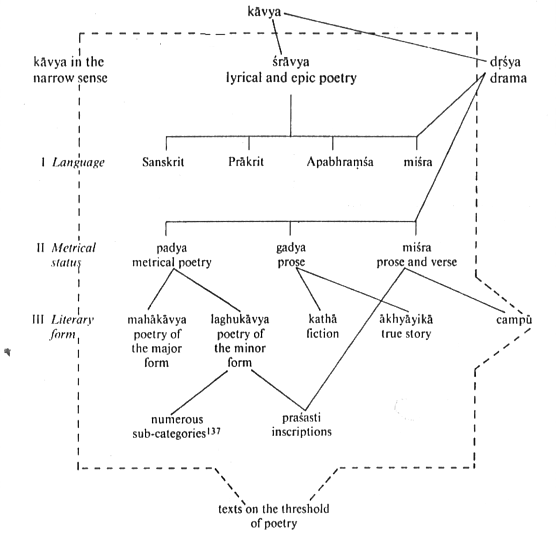

Zitierweise / cite as:
Payer, Alois <1944 - >: Einführung in die Exegese von Sanskrittexten : Skript. -- Kap. 8: Die eigentliche Exegese, Teil II: Zu einzelnen Fragestellungen synchronen Verstehens. -- Anhang A: Klassifikation belletristischer Sanskritliteratur nach Siegfried Lienhard. -- Fassung vom 2004-07-05. -- URL: http://www.payer.de/exegese/exeg08a.htm. -- [Stichwort].
Erstmals publiziert: 2004-07-05
Überarbeitungen:
Anlass: Lehrveranstaltung Proseminar Indologie WS 1995/96
©opyright: Dieser Text steht der Allgemeinheit zur Verfügung. Eine Verwertung in Publikationen, die über übliche Zitate hinausgeht, bedarf der ausdrücklichen Genehmigung des Verfassers.

Abb.: Siegfried Lienhard (1924 - ), Professor in Kiel (1962) und Stockholm (1967
- 1990)
Siegfried Lienhard gibt in
Lienhard, Siegfried <1924 - >: A history of classical poetry : Sanskrit - Pali - Prakrit / Siegfried Lienhard. -- Wiesbaden : Harrassowitz, 1984. -- VIII, 307 S. -- (A history of Indian literature : vol. 3 ; fasc. 1). -- ISBN 3-447-02425-9. -- S. 65
folgende Übersicht über die einheimische Klassifikation belletristischer Literatur:

Abb.: Schema der Klassifikation Lienhards (a.a.O., S. 65)
Lienhard erläutert: (ebd. S. 66):
"The maior and minor forms of poetry are generally called mahâkâvya and laghukâvya respectively, but some critics use other terms. It is important to note that Bhâmaha [see Kâvyâla.mkâra 1,30] and Vâmana [see Kâvyâla.mkârasûtrav.rtti 1,3,27] describe these two forms as nibaddha, 'cohesive (poetry)', and anibaddha, 'non-cohesive (poetry)'. Whereas nibaddha, which can be equated with mahâkâvya, includes both 'long poems' (in verse, prose or a mixture of the two) and drama, anibaddha, which is identical with the term laghukâvya, covers all kinds of metrical short poems, i.e. all poems consisting of one or only a few stanzas. The term mahâkâvya has a double meaning insofar as it is used of a) any long poem or b) the long poem par excellence, i.e., a verse poem consisting of a series of cantos (sarga). Although sargabandha, used in older poetic theory, is a singularly appropriate name, I sometimes use the term mahâkâvya, partly because this is the word most commonly used and partly because of the sharp contrast we thereba get between mahâ- and laghukâvya. The number of classifications and their nomenclatrure vary from theorist to theorist but the following are the terms generally used:
- muktaka - single-stanza poem
- yugmaka (also yugma, yugala or yugalaka) - two-stanza poem
- sandânitaka (or vi´se*saka) - three-stanza poem
- kapâlaka - four-stanza poem
- kulaka - five-to-fifteen-stanza poem
- sa*mghâta - series of stanzas
- ko´sa (or ko*sa) - collection of stanzas
- kha*n*dakâvya - short poetry
In a yugmaka, literally 'pair', the two stanzas are closely linked by both syntax and content. Both the muktaka and the yugmaka show a clear tendency to be constructed on the one-sentence-one-stanza principle, a characteristic we also find in the oldest Tamil poetry. If the number of stanzas exceed two, sandânitaka, 'the chain', kapâlaka, 'the group', or kulaka, 'the multitude', are the terms used which, if employed in a narrow sense, are the names given the poems of three, four or five to fifteen stanzas respectively. More controversial is the term sa*mghâta, 'junction'. This sort of poetry, longer than the kulaka and written all in the same metre, deals with one single theme through the whole series of stanzas: a mountain, a season, the pleasures experienced by a prince when bathing (jalavihâra) with the ladies of the court, a wedding, a battle, etc. The ko´sa, 'treasure', on the other hand is longer and exceedingly heterogeneous. These are anthologies, which are an extremely important category in Sanskrit and Prâkrit literature. They are collections of muktakas that have either all been written and arranged by one single hand or have been selected by an anthologist from the works of different poets. Collections either arrange the stanzas in an arbitrary order or on some definite principle such as the metre, alphabetically according to the first word in the stanza, the theme, etc. If poems are grouped by theme (for instance, the good man, the evil man, poets and poetry, the moon, the sun, the lion, the elephant, the camel, the peacock, etc., spring, summer, the monsoon, etc., love in union, the sulky beloved, the abandoned beloved, etc.) each theme is generally put into a special section (vrajyâ). Connoiseurs regard such ko´sas as delightful (manorama) as the unity of the verse spares the reader the distraction of having to readjust to different themes and alows him to enjoy undisturbed a whole section of poetry written in the same sentiment (rasa).
...
A more sharply defined category of laghukâvya is kha*n*dakâvya, which has an independent position between laghu- and mahâkâvya. The name means literally 'kâvya consisting of (only) one section (kha*n*da)'. It is frequently confused with sa*mghâta, but in fact there are two quite clear differences between the two: kha*n*dakâvya can employ themes much more freely and, even more important, it contains some kind of a story which, however limited or cursory and even when it is only intended to provide a background for the narrative, nevertheless acts as a vehicle that can vbear up the descriptive writing in the stanzas. The classic Kâlidâsa's 'Cloud Messenger' (Meghadûta) and Bilha*na's ' Fifty Stanzas concerning the Secret Enjoyment of Love' (Caurîsuratapañcâ´sikâ). As the title indicates, the latter consists of fifty stanzas whereas Kâlidâsa's poem has just over a hundred."
[Quelle: Lienhard, Siegfried <1924 - >: A history of classical poetry : Sanskrit - Pali - Prakrit / Siegfried Lienhard. -- Wiesbaden : Harrassowitz, 1984. -- VIII, 307 S. -- (A history of Indian literature : vol. 3 ; fasc. 1). -- ISBN 3-447-02425-9. -- S. 66]
Zurück zu Kapitel 8: Die eigentliche Exegese, Teil II: Zu einzelnen Fragestellungen synchronen Verstehens